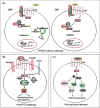Wnt Signaling in Kidney Development and Disease
- PMID: 29389516
- PMCID: PMC6008255
- DOI: 10.1016/bs.pmbts.2017.11.019
Wnt Signaling in Kidney Development and Disease
Abstract
Wnt signal cascade is an evolutionarily conserved, developmental pathway that regulates embryogenesis, injury repair, and pathogenesis of human diseases. It is well established that Wnt ligands transmit their signal via canonical, β-catenin-dependent and noncanonical, β-catenin-independent mechanisms. Mounting evidence has revealed that Wnt signaling plays a key role in controlling early nephrogenesis and is implicated in the development of various kidney disorders. Dysregulations of Wnt expression cause a variety of developmental abnormalities and human diseases, such as congenital anomalies of the kidney and urinary tract, cystic kidney, and renal carcinoma. Multiple Wnt ligands, their receptors, and transcriptional targets are upregulated during nephron formation, which is crucial for mediating the reciprocal interaction between primordial tissues of ureteric bud and metanephric mesenchyme. Renal cysts are also associated with disrupted Wnt signaling. In addition, Wnt components are important players in renal tumorigenesis. Activation of Wnt/β-catenin is instrumental for tubular repair and regeneration after acute kidney injury. However, sustained activation of this signal cascade is linked to chronic kidney diseases and renal fibrosis in patients and experimental animal models. Mechanistically, Wnt signaling controls a diverse array of biologic processes, such as cell cycle progression, cell polarity and migration, cilia biology, and activation of renin-angiotensin system. In this chapter, we have reviewed recent findings that implicate Wnt signaling in kidney development and diseases. Targeting this signaling may hold promise for future treatment of kidney disorders in patients.
Keywords: Wnt ligands; acute kidney injury; chronic kidney disease; nephrogenesis; renal fibrosis; renin–angiotensin system; β-catenin.
Copyright © 2018 Elsevier Inc. All rights reserved.
Figures



Similar articles
-
[Wnt/β-catenin signaling in kidney repair and fibrosis after injury].Sheng Li Xue Bao. 2022 Feb 25;74(1):15-27. Sheng Li Xue Bao. 2022. PMID: 35199122 Chinese.
-
New insights into the role and mechanism of Wnt/β-catenin signalling in kidney fibrosis.Nephrology (Carlton). 2018 Oct;23 Suppl 4:38-43. doi: 10.1111/nep.13472. Nephrology (Carlton). 2018. PMID: 30298654 Review.
-
Wnt/β-catenin regulates blood pressure and kidney injury in rats.Biochim Biophys Acta Mol Basis Dis. 2019 Jun 1;1865(6):1313-1322. doi: 10.1016/j.bbadis.2019.01.027. Epub 2019 Jan 30. Biochim Biophys Acta Mol Basis Dis. 2019. PMID: 30710617 Free PMC article.
-
Wnt/β-catenin signaling and kidney fibrosis.Kidney Int Suppl (2011). 2014 Nov;4(1):84-90. doi: 10.1038/kisup.2014.16. Kidney Int Suppl (2011). 2014. PMID: 26312156 Free PMC article. Review.
-
WNT/beta-catenin signaling in nephron progenitors and their epithelial progeny.Kidney Int. 2008 Oct;74(8):1004-8. doi: 10.1038/ki.2008.322. Epub 2008 Jul 16. Kidney Int. 2008. PMID: 18633347 Free PMC article. Review.
Cited by
-
CXC Chemokine Receptor 2 Accelerates Tubular Cell Senescence and Renal Fibrosis via β-Catenin-Induced Mitochondrial Dysfunction.Front Cell Dev Biol. 2022 May 3;10:862675. doi: 10.3389/fcell.2022.862675. eCollection 2022. Front Cell Dev Biol. 2022. PMID: 35592244 Free PMC article.
-
Store-operated calcium entry: Pivotal roles in renal physiology and pathophysiology.Exp Biol Med (Maywood). 2021 Feb;246(3):305-316. doi: 10.1177/1535370220975207. Epub 2020 Nov 29. Exp Biol Med (Maywood). 2021. PMID: 33249888 Free PMC article. Review.
-
Selenium Deficiency Leads to Changes in Renal Fibrosis Marker Proteins and Wnt/β-Catenin Signaling Pathway Components.Biol Trace Elem Res. 2022 Mar;200(3):1127-1139. doi: 10.1007/s12011-021-02730-1. Epub 2021 Apr 24. Biol Trace Elem Res. 2022. PMID: 33895963
-
LncRNA GAS5 Competitively Combined With miR-21 Regulates PTEN and Influences EMT of Peritoneal Mesothelial Cells via Wnt/β-Catenin Signaling Pathway.Front Physiol. 2021 Aug 30;12:654951. doi: 10.3389/fphys.2021.654951. eCollection 2021. Front Physiol. 2021. PMID: 34526907 Free PMC article.
-
Inactivation of the Wnt/β-catenin signaling contributes to the epithelial barrier dysfunction induced by sodium oxalate in canine renal epithelial cells.J Anim Sci. 2021 Oct 1;99(10):skab268. doi: 10.1093/jas/skab268. J Anim Sci. 2021. PMID: 34549281 Free PMC article.
References
-
- Nusse R, Clevers H. Wnt/beta-catenin signaling, disease, and emerging therapeutic modalities. Cell. 2017;169:985–999. - PubMed
-
- Nusse R, Varmus HE. Many tumors induced by the mouse mammary tumor virus contain a provirus integrated in the same region of the host genome. Cell. 1982;31:99–109. - PubMed
-
- Clevers H, Nusse R. Wnt/beta-catenin signaling and disease. Cell. 2012;149:1192–1205. - PubMed
Publication types
MeSH terms
Substances
Grants and funding
LinkOut - more resources
Full Text Sources
Other Literature Sources
Medical

